INSTITUT SUPERIEUR D'ANTHROPOLOGIE
INSTITUTE OF ANTHROPOLOGY
ONLINE COURSES / COURS A DISTANCE
FALL TERM : OCTOBER 2015
REGISTER NOW
PEROU – 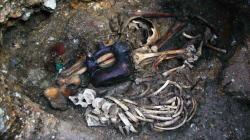 Kuntur Wasi - A team of Japanese and Peruvian researchers has found in northern Peru an intact 2,700-year-old tomb containing the remains of two high priests from the ancient Pacopampa culture. The discovery was made in the Cajamarca region, 500 miles north of Lima. Project co-director Daniel Morales told EFE the team informally dubbed the structure the "Tomb of the Serpent-Jaguar Priests," after a ceramic vessel in the shape of a serpent with a jaguar's head found alongside one of the bodies. One of the individuals was buried with a necklace of 13 oval-shaped gold beads engraved with figure-eights, while the second was accompanied by the Serpent-Jaguar vessel, which is 8- inches tall and has a stirrup-like handle. The first body was buried facing south, while the second is pointed to the north. They lie on one side of a large square surrounded by sculpted walls of stones, with two stairways providing access. "Finding these remains in the same place where rituals and feasts were held, we assume they could have been priests in charge of ceremonies during this culture's peak, between 800 and 500 B.C.," Morales said. The Pacopampa project brings together researchers from Japan's National Ethnology Museum and Peru's San Marcos University under the leadership of Japanese archaeologist Yuji Seki. The discovery of the two priests ranks with similar findings at the Kuntur Wasi site in Cajamarca, Seki said in a statement. The Pacopampa culture developed between 1200 and 500 B.C. at an altitude of roughly 6,885 feet in the Andes.
Kuntur Wasi - A team of Japanese and Peruvian researchers has found in northern Peru an intact 2,700-year-old tomb containing the remains of two high priests from the ancient Pacopampa culture. The discovery was made in the Cajamarca region, 500 miles north of Lima. Project co-director Daniel Morales told EFE the team informally dubbed the structure the "Tomb of the Serpent-Jaguar Priests," after a ceramic vessel in the shape of a serpent with a jaguar's head found alongside one of the bodies. One of the individuals was buried with a necklace of 13 oval-shaped gold beads engraved with figure-eights, while the second was accompanied by the Serpent-Jaguar vessel, which is 8- inches tall and has a stirrup-like handle. The first body was buried facing south, while the second is pointed to the north. They lie on one side of a large square surrounded by sculpted walls of stones, with two stairways providing access. "Finding these remains in the same place where rituals and feasts were held, we assume they could have been priests in charge of ceremonies during this culture's peak, between 800 and 500 B.C.," Morales said. The Pacopampa project brings together researchers from Japan's National Ethnology Museum and Peru's San Marcos University under the leadership of Japanese archaeologist Yuji Seki. The discovery of the two priests ranks with similar findings at the Kuntur Wasi site in Cajamarca, Seki said in a statement. The Pacopampa culture developed between 1200 and 500 B.C. at an altitude of roughly 6,885 feet in the Andes.
http://latino.foxnews.com/latino/lifestyle/2015/09/17/intact-2700-year-old-tomb-found-in-northern-peru/?
ROYAUME UNI –  Auchnacraig Park - A team of archaeology students from Glasgow University revealed a small part of the stone for the first time since it was buried by archaeologists in 1964. The Cochno Stone, in Auchnacraig Park, Faifley, is one of the largest and most spectacular panels of prehistoric rock-art in Britain. The markings on the stone’s surface were probably carved between 3000 and 2000BC, a period known as the Late Neolithic and early Bronze Age. The carvings were first recorded in the 1880s and included dozens of hollows, better known as cup-marks, and concentric circles, known as cup-and-ring marks. Other markings include spirals, and a pair of feet each with four toes, which may be Victorian additions to the rock outcrop. The Cochno Stone was buried beneath up to one metre of soil in 1964 by archaeologists due to fears of vandalism and graffiti on the rock, and damage caused by visitors walking over the rock-art. Last week, a small section of the Cochno Stone was exposed when archaeologists removed the topsoil over a small section of the rock. The rock does not seem to have been damaged by being covered up, and the team discovered several impressive cup-and-rings marks in very good condition. The excavation is the first step in a collaborative project between Glasgow University and Spanish digital heritage company Factum Arte, to uncover the Cochno Stone completely and create an exact replica based on a highly accurate laser survey of the stone’s surface. It is hoped that this replica can be located in Auchnacraig Park.
Auchnacraig Park - A team of archaeology students from Glasgow University revealed a small part of the stone for the first time since it was buried by archaeologists in 1964. The Cochno Stone, in Auchnacraig Park, Faifley, is one of the largest and most spectacular panels of prehistoric rock-art in Britain. The markings on the stone’s surface were probably carved between 3000 and 2000BC, a period known as the Late Neolithic and early Bronze Age. The carvings were first recorded in the 1880s and included dozens of hollows, better known as cup-marks, and concentric circles, known as cup-and-ring marks. Other markings include spirals, and a pair of feet each with four toes, which may be Victorian additions to the rock outcrop. The Cochno Stone was buried beneath up to one metre of soil in 1964 by archaeologists due to fears of vandalism and graffiti on the rock, and damage caused by visitors walking over the rock-art. Last week, a small section of the Cochno Stone was exposed when archaeologists removed the topsoil over a small section of the rock. The rock does not seem to have been damaged by being covered up, and the team discovered several impressive cup-and-rings marks in very good condition. The excavation is the first step in a collaborative project between Glasgow University and Spanish digital heritage company Factum Arte, to uncover the Cochno Stone completely and create an exact replica based on a highly accurate laser survey of the stone’s surface. It is hoped that this replica can be located in Auchnacraig Park.
http://www.clydebankpost.co.uk/news/roundup/articles/2015/09/17/544505-historic-cochno-stone-uncovered-by-archaeologists/
ROYAUME UNI – 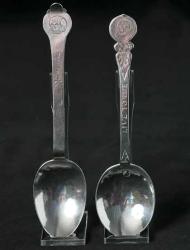 York - Two macabre spoons from the Merchant Adventurers' Hall in York. These death’s head or funeral spoons were made for presentation to members of the deceased’s family during the 17th century. Relatively few remain, probably because they were rather gruesome and were not kept for long. The spoon on the left was made in York by Thomas Mangy in around 1666. The reverse bears the Arms of Crompton of Driffield, East Yorkshire. It measures 185 mm and weighs 42.5g. The one on the right, a silver spoon with a shallow bowl, is engraved on the front of the stem ‘Live to die’, with the reverse reading ‘Die to live’. On the top of the stem is a small engraved skull and on the reverse the Arms of the Strickland family of Boynton Hall, near Bridlington, East Yorkshire. It is seven millimetres smaller and weighs 46.6g. It appears that the spoons highlighted the importance in the early 17th Century of Memento Mori (Latin for ‘remember (that you have) to die’). The idea was of perfecting your character and living a good life, as everything is transient and not to be hung up on earthly goods and pleasures. This seems to have been particularly relevant to a number of wealthy merchants of the York Company of Merchant Adventurers during this time.
York - Two macabre spoons from the Merchant Adventurers' Hall in York. These death’s head or funeral spoons were made for presentation to members of the deceased’s family during the 17th century. Relatively few remain, probably because they were rather gruesome and were not kept for long. The spoon on the left was made in York by Thomas Mangy in around 1666. The reverse bears the Arms of Crompton of Driffield, East Yorkshire. It measures 185 mm and weighs 42.5g. The one on the right, a silver spoon with a shallow bowl, is engraved on the front of the stem ‘Live to die’, with the reverse reading ‘Die to live’. On the top of the stem is a small engraved skull and on the reverse the Arms of the Strickland family of Boynton Hall, near Bridlington, East Yorkshire. It is seven millimetres smaller and weighs 46.6g. It appears that the spoons highlighted the importance in the early 17th Century of Memento Mori (Latin for ‘remember (that you have) to die’). The idea was of perfecting your character and living a good life, as everything is transient and not to be hung up on earthly goods and pleasures. This seems to have been particularly relevant to a number of wealthy merchants of the York Company of Merchant Adventurers during this time.
http://www.culture24.org.uk/history-and-heritage/archaeology/art536995-death-head-spoons-merchant-adventurer-hall-york
ROYAUME UNI – 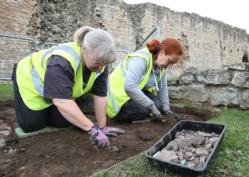 Conisbrough Castle - An archaeological dig to uncover the 11th century secrets of historic Conisbrough Castle has got underway. In 2014 evidence of a major ditch cutting across the promontory was discovered. By revisiting the area the team will attempt to determine its purpose and date, as well as looking for evidence of an early earthen bank pre-dating the stone curtain wall.
Conisbrough Castle - An archaeological dig to uncover the 11th century secrets of historic Conisbrough Castle has got underway. In 2014 evidence of a major ditch cutting across the promontory was discovered. By revisiting the area the team will attempt to determine its purpose and date, as well as looking for evidence of an early earthen bank pre-dating the stone curtain wall.
VIDEO = http://www.doncasterfreepress.co.uk/news/video-dig-to-unearth-conisbrough-castle-s-past-1-7465862
TURQUIE – 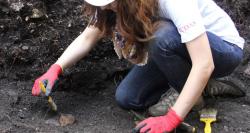 Giresun Island - Byzantine-era archaeological findings have been discovered on Giresun Island, a small island about 1 kilometer off the coast of the northeastern city of Giresun, as part of the excavations that started this month. Archaeologists uncovered a Byzantine-era chapel and pitos, a storage area in the shape of giant jar, along with other artifacts including Byzantine-era coins. The ruins of a monastery were discovered in the area, and it also features a cistern and the ruins of a tower. The island has been continuously inhabited without interruption since the third century B.C. In the sixth or fifth century B.C., the island was used by ancient Greek colonists from the city of Kerasous (presently Giresun). Several names were given to the island by the Greeks, including Ares, Nesos and Puga. The Romans established a walled settlement with towers on the island to defend against pirate raids on the dual-province of Pontus and Bithynia in the first century A.D. In the middle of the Byzantine era – around the fifth-to-sixth centuries – a monastery was constructed on the island. J. Philipp Fallmerayer, an Austrian traveler, journalist, politician and historian who visited the island in 1840, reported that the ruined monastery was dedicated to St. Phocas of Sinope.
Giresun Island - Byzantine-era archaeological findings have been discovered on Giresun Island, a small island about 1 kilometer off the coast of the northeastern city of Giresun, as part of the excavations that started this month. Archaeologists uncovered a Byzantine-era chapel and pitos, a storage area in the shape of giant jar, along with other artifacts including Byzantine-era coins. The ruins of a monastery were discovered in the area, and it also features a cistern and the ruins of a tower. The island has been continuously inhabited without interruption since the third century B.C. In the sixth or fifth century B.C., the island was used by ancient Greek colonists from the city of Kerasous (presently Giresun). Several names were given to the island by the Greeks, including Ares, Nesos and Puga. The Romans established a walled settlement with towers on the island to defend against pirate raids on the dual-province of Pontus and Bithynia in the first century A.D. In the middle of the Byzantine era – around the fifth-to-sixth centuries – a monastery was constructed on the island. J. Philipp Fallmerayer, an Austrian traveler, journalist, politician and historian who visited the island in 1840, reported that the ruined monastery was dedicated to St. Phocas of Sinope.
http://www.dailysabah.com/history/2015/09/17/byzantine-era-ruins-unearthed-on-black-sea-island
INDE – 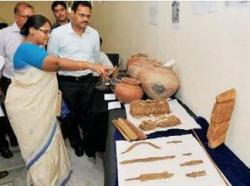 Telangana - The Telangana state archaeology department displayed a rich haul of artefacts that it had come to possess recently at a media briefing on Wednesday. The artefacts that were showcased included 40 gold coins discovered in Khammam district dating back to Krishnadevaraya period. During the meet the officials said that the coins were found by four people in an open field. The scuffle among the four about the sharing of the gold coins caught the attention of the police who subsequently seized them from the villagers and handed over to the archaeology department. The coins bear inscriptions in Nagari script. The other artefacts were 55 palm leaf manuscripts found by chance by a schoolgirl in Nalgonda district. The girl, Krishnaveni, was cleaning her school as part of the 'Swachh Bharat' mission when she stumbled upon them. The manuscripts are said to contain scriptures eritten in modern Telugu. The manuscripts throw light on 'Bandila Magga Maya Charitra' consisting of Amaraveerula Chandrika Charitra, Vykuntapura Charitra, Raghunama Puradesa Charitra, Mandathadivya Charitravali and the Malayella Rajula Divya Vali Charitra and also a Kirtana composed in Kambojaraga. This manuscript would be treated chemically and then displayed in the district archaeological museum, Warangal for public view. The other items that were displayed at the meeting were tools, weapons and bones discovered from three burial sites during excavations in Medak district. Officials said that they would soon hand over the artefacts to the Centre for Cellular and Molecular Biology (CCMB) for radiocarbon dating.
Telangana - The Telangana state archaeology department displayed a rich haul of artefacts that it had come to possess recently at a media briefing on Wednesday. The artefacts that were showcased included 40 gold coins discovered in Khammam district dating back to Krishnadevaraya period. During the meet the officials said that the coins were found by four people in an open field. The scuffle among the four about the sharing of the gold coins caught the attention of the police who subsequently seized them from the villagers and handed over to the archaeology department. The coins bear inscriptions in Nagari script. The other artefacts were 55 palm leaf manuscripts found by chance by a schoolgirl in Nalgonda district. The girl, Krishnaveni, was cleaning her school as part of the 'Swachh Bharat' mission when she stumbled upon them. The manuscripts are said to contain scriptures eritten in modern Telugu. The manuscripts throw light on 'Bandila Magga Maya Charitra' consisting of Amaraveerula Chandrika Charitra, Vykuntapura Charitra, Raghunama Puradesa Charitra, Mandathadivya Charitravali and the Malayella Rajula Divya Vali Charitra and also a Kirtana composed in Kambojaraga. This manuscript would be treated chemically and then displayed in the district archaeological museum, Warangal for public view. The other items that were displayed at the meeting were tools, weapons and bones discovered from three burial sites during excavations in Medak district. Officials said that they would soon hand over the artefacts to the Centre for Cellular and Molecular Biology (CCMB) for radiocarbon dating.
http://timesofindia.indiatimes.com/city/hyderabad/Archaeology-dept-in-Telangana-gets-hold-of-Krishnadevaraya-era-gold-coins/articleshow/48992477.cms